
https://www.youtube.com/watch?v=I2JGiSMF1UE
Statics: Lesson 8 - Intro to 3D Vectors, Deriving Blue Triangle Equations (Spherical Coordinates)
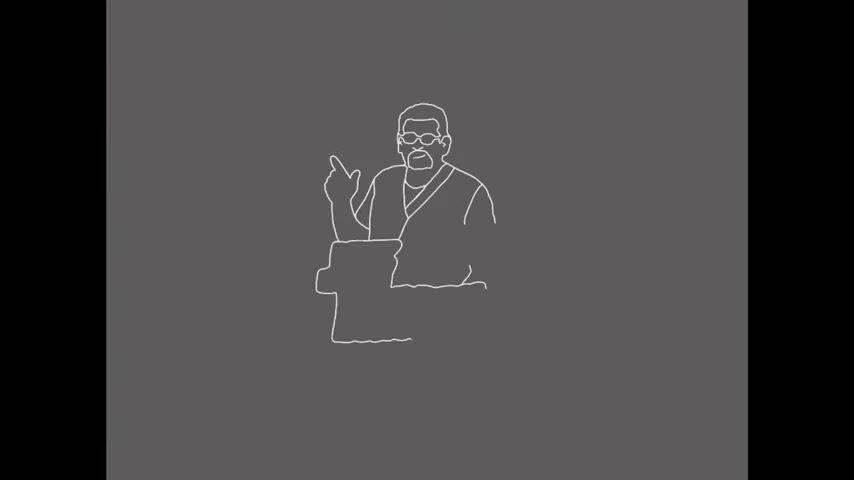
Hey , friends .
Welcome back to the channel .
Today , we're talking about intro to 3 d vectors .
Now we master 2 d vectors .
We're like level 3 experts at that .
It's time to move on to 3 d .
Now the whole goal about the next couple videos , what I'm gonna be talking about , the whole point of it .
Okay ?
Don't be scared of 3 d because the whole point is just to take a 3 d vector such as this vector here .
K ?
There's some vector .
It goes from the origin to that opposite corner of that cube .
Take that 3 d vector , and we'll call him vector f , and break him into components , I hat , j hat , k hat .
Because if I could take a 3 d vector and break it into I , j , and k , then I can add up a 100 of them .
Right ?
Add all the i's together , add all the j's together , all the k's together .
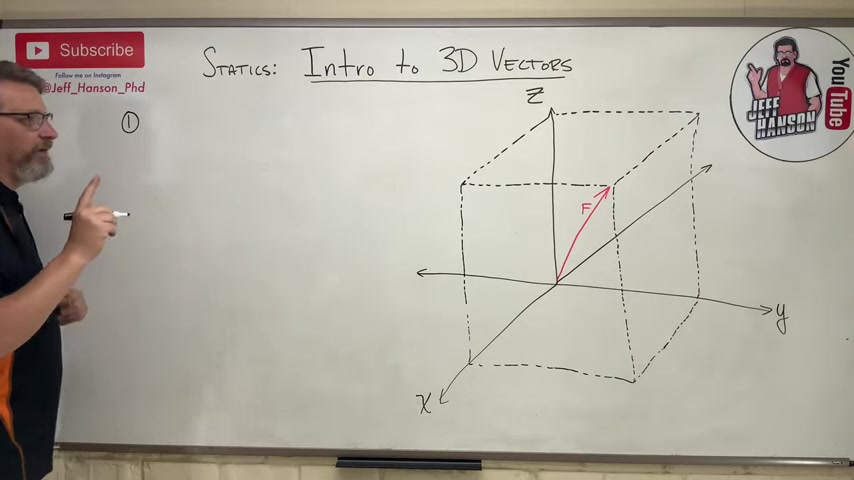
So everything I'm gonna be doing in the next couple videos is showing you how to take a 3 d vector and make it into I hat , j hat , k n .
That's it .
Okay ?
So don't think , oh , this is gonna be hard .
It's it's not hard .
Okay ?
There are 3 ways , k , that a vector can be expressed in 3 d .
Three ways .
And this , that I'm gonna talk to you on this video , is about way number 1 .
K ?
Number 1 .
And I call this the blue triangle triangle triangle .
Sorry , my speller quit working there in my brain .
Equations .
Okay ?
The blue triangle equations .
Now the reason I call it the blue triangle equations is because in the book , these problems I'm looking for my book .
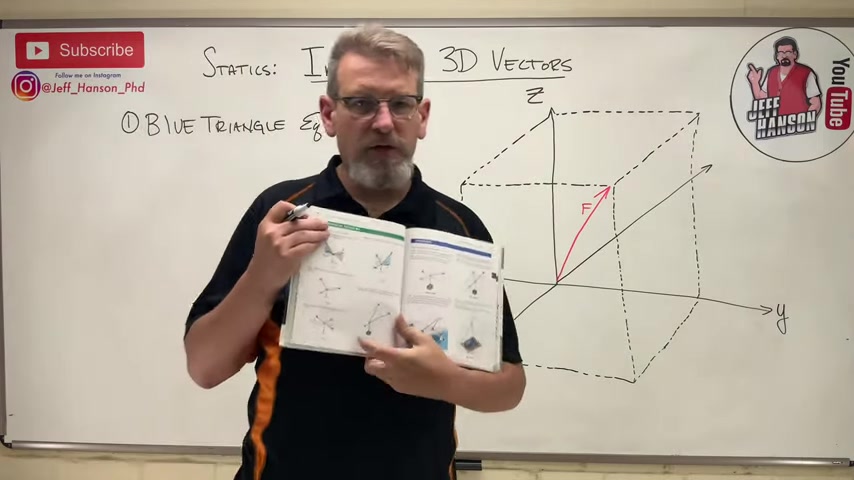
So in the book , these problems always have or they're expressed with these little blue triangles .
Okay ?
So this particular method , I just call it the blue triangle questions .
You won't find that in the book .
I just I made that up .
Okay ?
So I'm gonna show you how to derive those , how to use them , and you're gonna be like , man , that was so easy .
Okay ?
One of the things that I wanna do is I wanna tell you that a 3 d vector , just like a 2 d vector , has projections onto the axes .
Okay ?
So this vector f would have 3 components .
Instead of 2 and 2 d , it has 3 and 3 d .
It has this guy .
Okay .
That's f x .
Has this guy .
That's f y .
And of course it has this guy .
And that's fz .
Okay ?

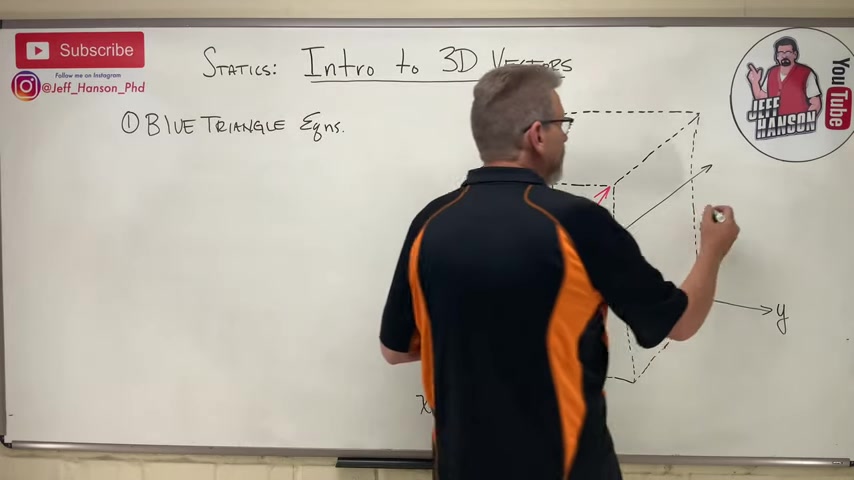
So that 3 d vector has 3 components .
And the same as it was in 2 d , if I take if I want to know the magnitude of vector f , well , it's the square root of fxsquaredplusfysquaredplusfzsquared .
Okay ?
So find magnitude in 3d the exact same way we do in 2d .
So that's easy to do .
Okay .
Now one of the things I want to kind of tell you about is this , I want to imagine that vector f is contained inside of a plane .
And that plane is right here and right here .
Okay .
So kind of this this plane here , okay .
Imagine that plane as a door .
Okay .
And that door used to be over here on the x axis and it's going and it's opened up .
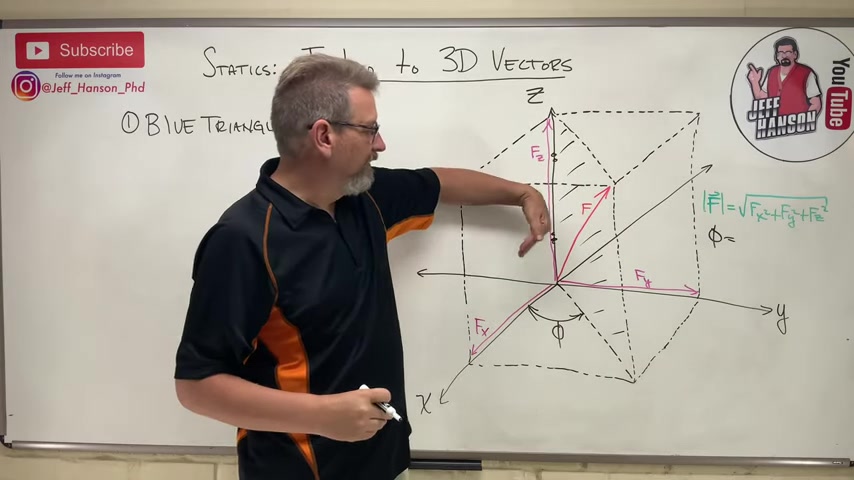
How much is it opened up ?
It's opened up this much .
Okay .
And we call this angle phi .
Okay .
Angle phi .
Now let me write it over here .
Phi okay .
I call angle phi the swing angle .
Because imagine that as a door and it's hinged , like here's the hinges .
Right ?
There's a hinge here .
There's a hinge here .
Right ?
It's hinged on the z axis and it's allowed to swing .
And it can swing that way or it can swing this way .
It doesn't matter .
But that I call it the swing angle .
And again , don't go looking for that in the book because I just made it up .
Okay ?
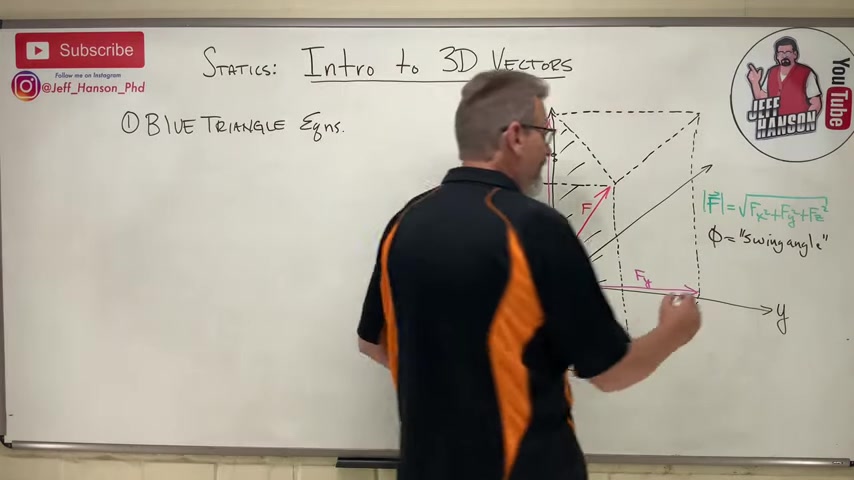
And angle phi is the angle between the positive x axis and the bottom of I'm gonna call it the door .
It's not really the door , but it's the plane .
So and the bottom of the plane , let's call it f h for hypotenuse .
Right ?
This is f h also .
Right ?
That's the hypotenuse of the door .
Okay ?
So that's one angle .
I need one more angle because in 3d in 2d , I could give you a vector and just say , hey , a vector is at 30 degrees and you go , okay , boom , there's 0 and then , well , there's 30 degrees , there's my vector .
Right ?
But in 3 d , I gotta tell you a little more .
I gotta tell you , like , what the inclination is and then I gotta tell you , like , which way it is this way .
Right ?
So phi is the one that tells me where it is this way .

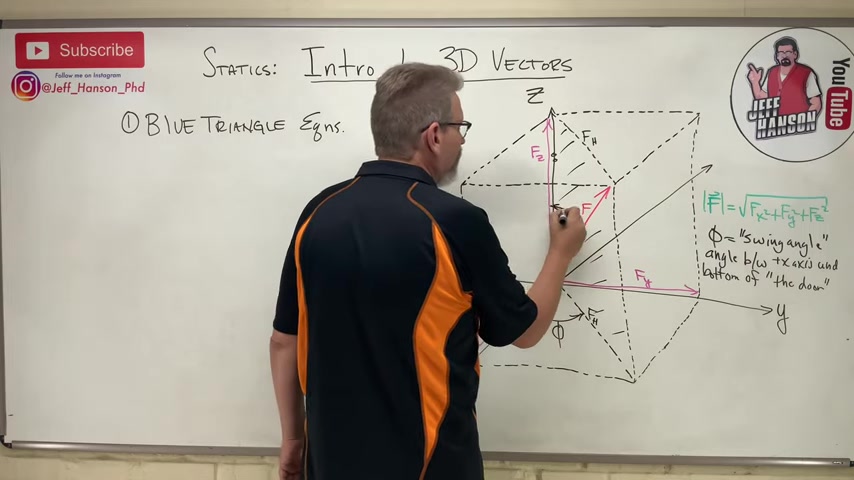
Now I need one that tells me this way .
Right ?
And we call this guy we call this guy theta z .
Okay .
So that's the second angle .
So theta z is the angle between positive z and vector f .
Okay .
So positive z straight up , down .
Okay .
So here's here's theta z is from positive z down to the vector .
Okay .
Now this is the least amount of information that you can possibly have in order to describe a three d vector would be the magnitude , so I need to know how big it is , that would be just f .
And then those two angles , I need to know phi and theta z .
Once I know that , I know the I hat , the j hat , and the k hat every time .
Okay ?
So we're gonna use something called SOHCAHTOA .
Have you ever heard of it ?
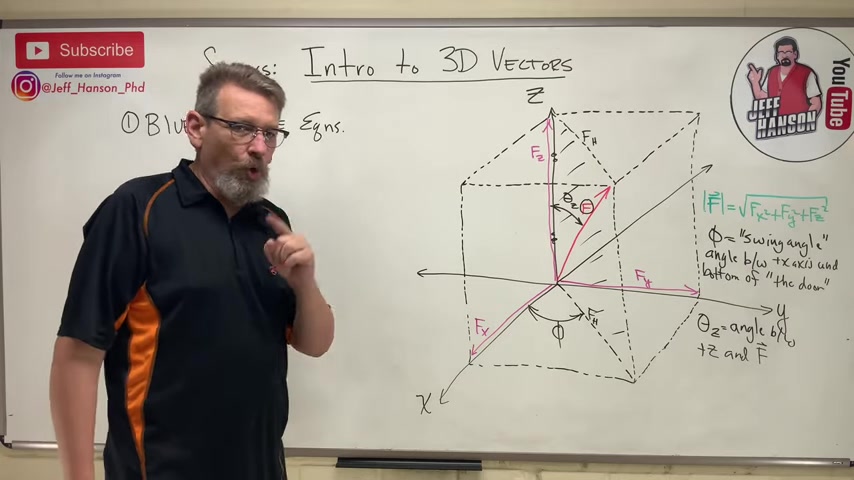
We're gonna use a little simple trig and we're gonna derive some equations .
And the goal here is to take that 3 d vector and break them into 3 parts .
F x , f y , and f z .
Right ?
I hat , j hat , k hat .
If I can break it into 3 components like that , dude , I can write it in our Cartesian 4 and I can add 50 of them together .
No problemo .
Okay ?
So step 1 , let's get in a helicopter .
Okay ?
And we're going up here and we're gonna hover straight above this and we're gonna look straight down on that system .
So what would you see if you look straight down that system ?
Well , you would see this .
K .
Here's that y axis .
Here's the x axis .
And here is something .
Okay .
And here is that angle phi right there .
K .
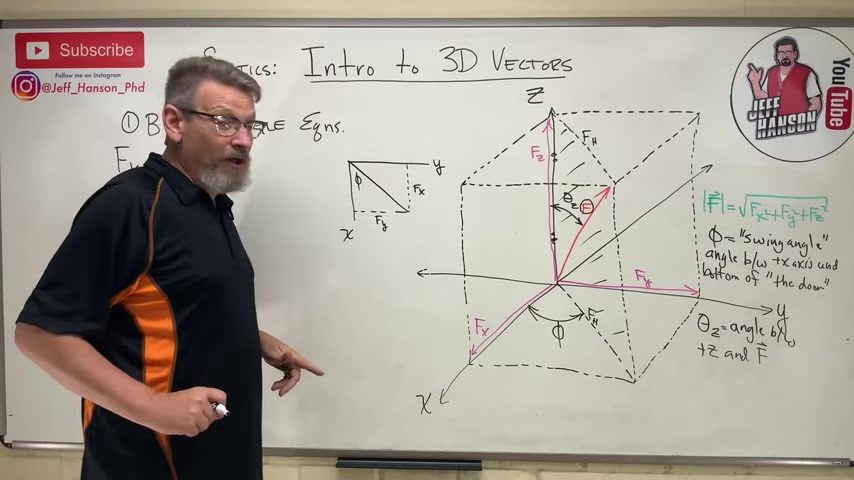
So question and this is , this will be f x and this will be f y .
K ?
Because if this is f x , right , so is that over there .
If this is f y , then so is that over there .
Right ?
Now what am I looking at right here ?
What is that ?
Now I'm in a helicopter looking straight down on it .
Right ?
Johnny Weekes , he would say , oh , that's vector f .
Nuh-uh .
If you were looking straight down on that door , what would you see ?
You'd just see the top of the door , wouldn't you ?
K .
That's actually f h .
K .
So let's do sine and cosine for this triangle right here .
Okay ?
This is f x over here as well .
K .
So here we go , cosine .
Cosine of phi is equal to opposite ?
No .
No .
That's sine .
Adjacent over hypotenuse , fx over f h .

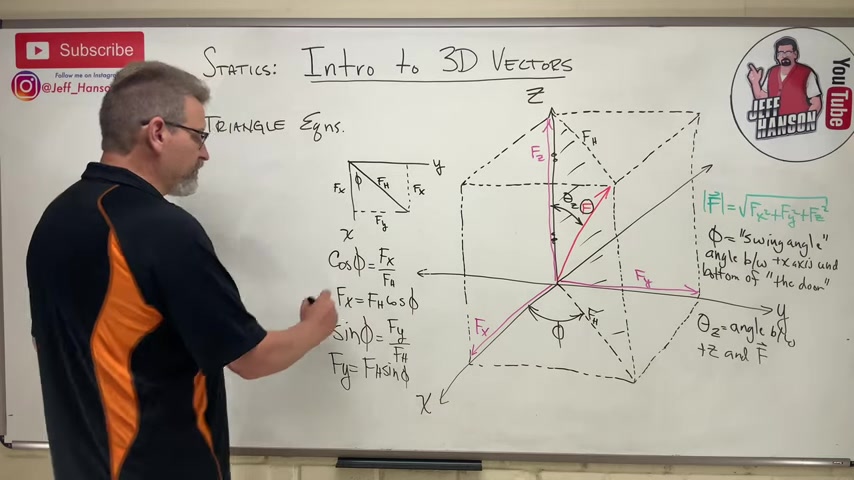
So we can rearrange that and we can say that fx is equal to fhcosine of phi .
Alright .
Same equation , let's do sine .
Okay .
So sine of phi .
And sine is opposite , boom , over hypotenuse .
So f y over f h .
So let's see f y , we could rearrange this again , f y is equal to f h sine of phi .
Okay ?
So there's 2 little nifty equations for f x and f y .
Alright ?
Let's do one more thing .
Let's look at this door , the plane that contains vector f .
Okay ?
Look at the door .
But let's look at it straight on .
So we're looking straight at the door .
K ?
What would we see ?
Here's the door .
Oh , that's not a very straight line , doctor Hansen .
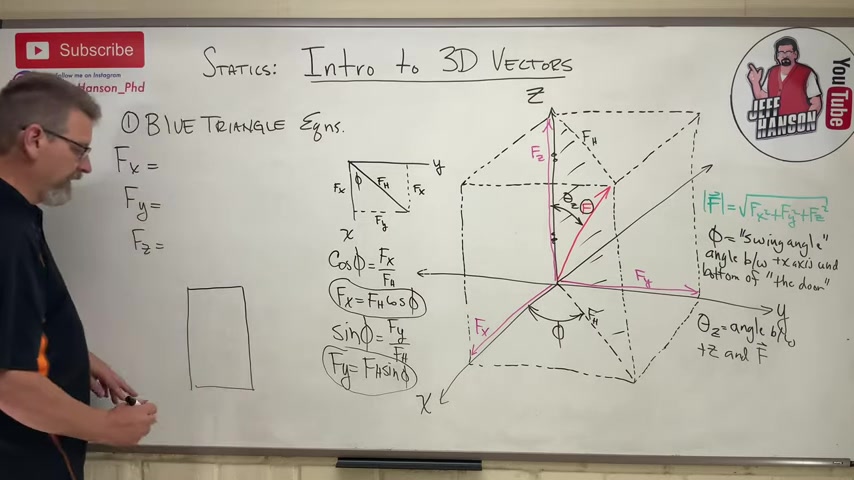
Okay .
I'll fix it .
Okay .
There's the door .
K ?
Here's vector f right here .
It goes from one corner .
Golly , man .
I'm like king of the crooked lines today , aren't I ?
K .
That's pretty straight .
There's vector f .
K .
The top of the door is f h .
The bottom of the door is f h .
And this is f z .
And this is f z .
And here's theta z .
K ?
I wanna do the exact thing I did over there , little SOH CAH TOA to this triangle right here one more time .
And what am I gonna get ?
Okay .
For this triangle , I get this .
Cosine of theta z is equal to adjacent over hypotamus , so f z over f .
Okay .
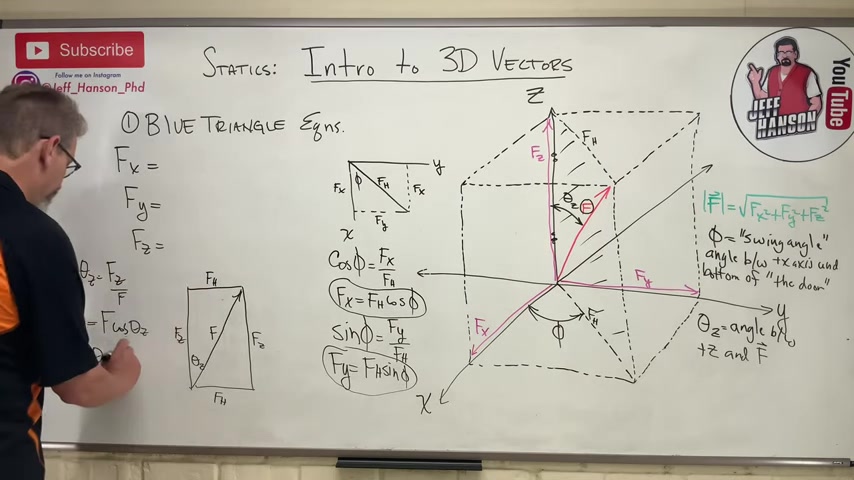
And again , I can rearrange that and I get this , f z is equal to fcosethetaz .
Okay .
And let's do sine .
Sine of thetaz is equal to sine is opposite over above this , so f h over f .
And one more time I can rearrange this guy and I get f h is equal to f sine theta z .
Okay ?
So I have 2 more equations there and there .
Now the overall goal here was to be able to write an fx , an fy , and an fz .
Because if I can get an I j and k , man , I can go to town , yo .
Okay .
So you know what I'm not in love with ?
I'm not in love with f h .
I just want x , y , and z .
I don't need f h in my life , do I ?
K .

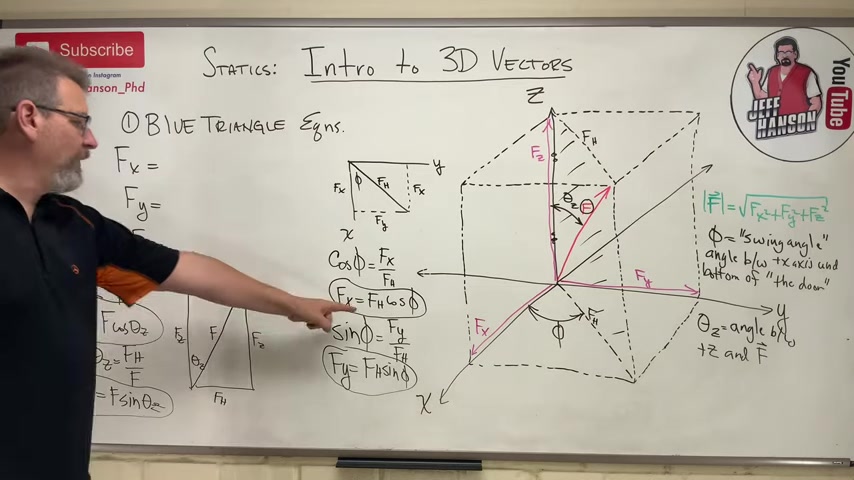
So if only I had an equation for f h , that way I could substitute in .
Oh my goodness .
There's one right there .
So let's substitute that in for there .
Okay ?
So f x is equal to f h which is f sine theta z .
K .
And then cosine phi .
K .
And then f y , well he has an f h so I'm gonna substitute again and then sign of and then f z , you know what , f z is okay .
He doesn't have any weird stuff in him so he's just f cos theta z .
Okay .
Boom .
We just did it y'all .
We just did it .
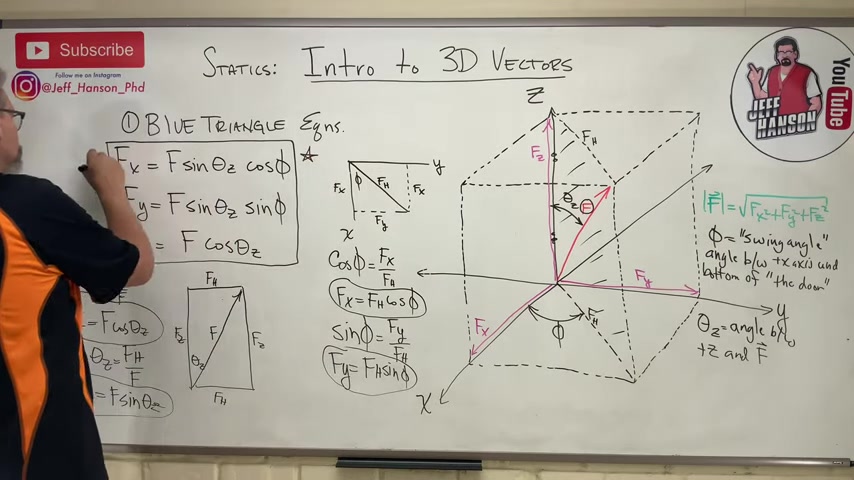
Now that one really hard because all we used was SOHCAHTOA , but you should put a star by that .
K .
Those are the blue triangle equations .
Okay ?
Those are the blue triangle equations .
Those are the ones that you should remember and , helpful on the test to remember that .
Okay ?
These are the blue triangle equations .
Alright ?
So what do you need to use the blue triangle equations ?
What do you need ?
Well , you need to look at one of those blue triangle problems and you need to identify 3 things .
Number 1 , what is f ?
Which is generally given .
They'll tell you , hey , the magnitude of this vector is 300 newtons or something like that .
Right ?
That's pretty much given .
What is phi ?
Okay .
Well , you all you have to do is remember , what was phi ?
Oh , yeah .
It's the swing angle .
It's the angle between the positive x axis in and the bottom of the door .
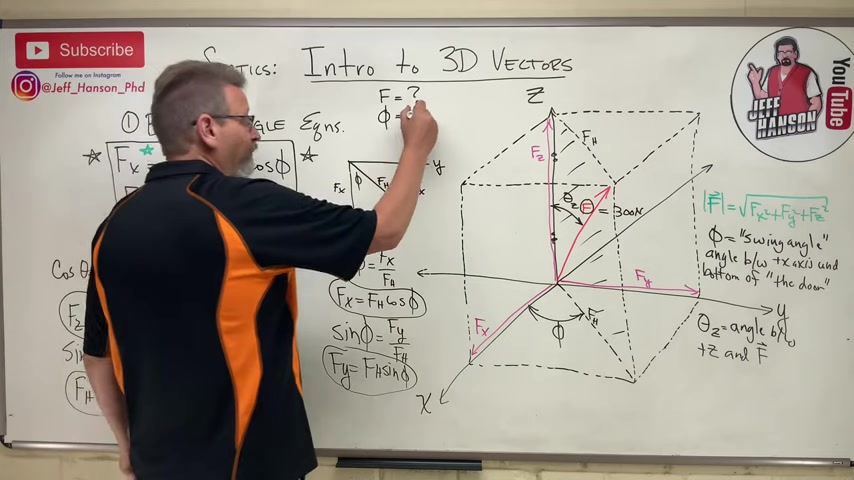
And if you can find that angle , dude , all you gotta do is plug it into these equations .
So phi equals what ?
And then finally , what does theta z equal ?
Right ?
So if I and and there it is , from positive z down to the vector .
So if I can identify those three things , I can plug them into those three equations and then just solve them .
I just turn the crank in my calculator .
Right ?
And I'm done .
Here's the deal that is nice about these equations .
Okay ?
Number 1 , they just came from SoCoteau .
Number 2 is if you put the right thing in these equations , it will give you the right sign out .
Okay ?
Because you can look at a vector .
Like this vector here , I can see has a positive x , a positive y , and a positive z .
So when I put my stuff in these equations , I'm gonna get a positive , a positive , and a positive .
If I don't , if the calculator gives me a negative for one of these , then I did something wrong .
Now here's the other thing .

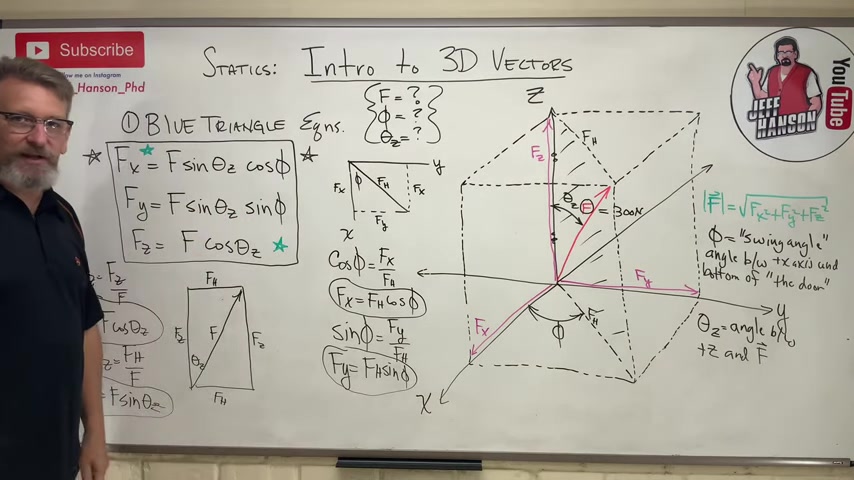
On the other hand , if you put garbage in for these variables , right , if you put garbage into those equations , guess what you're gonna get out ?
Garbage .
Okay .
So that's how that's where they come from .
The the main thing is I want you to do you'll be able to do is identify what is fee , what is state of z .
Okay ?
In the next video , what I'm gonna do is I'm gonna put a whole bunch of those up here on the board , and I'm gonna drill you over it .
Okay ?
I'm gonna ask you over and over .
What's fee ?
What's state of z ?
And you're gonna push pause and you're gonna tell me .
Okay ?
So I'm gonna drill you on this because once you can start identifying what is phi and what is saying to z , how easy is this ?
Just plug it in .
Put it in your calculator .
Done .
Right ?
Easy .
I hat , j hat , k hat .
Okay ?
So get ready for some exercise .
I'm fixing to drill you on some , on some problems .
Hang on .
Are you looking for a way to reach a wider audience and get more views on your videos?
Our innovative video to text transcribing service can help you do just that.
We provide accurate transcriptions of your videos along with visual content that will help you attract new viewers and keep them engaged. Plus, our data analytics and ad campaign tools can help you monetize your content and maximize your revenue.
Let's partner up and take your video content to the next level!
Contact us today to learn more.